Civil Engineering Technology Report: Construction Project Analysis
VerifiedAdded on 2022/08/23
|19
|3932
|20
Report
AI Summary
This report provides a comprehensive analysis of civil engineering technology, focusing on the establishment of an industrial unit. It delves into various aspects of a construction project, starting with earthworks, including excavation, transportation, and material placement. The report then explores the creation of complex foundations, piling works, and drainage systems. It further examines the construction of underpasses and culverts, as well as the establishment of office blocks and mitigation of slope instabilities. The second part of the report focuses on safety, risk, and hazard management, including method statements for installation programs and a detailed safety plan. It also addresses civil construction health and safety codes and regulations. The final section assesses the potential environmental impacts of the construction, particularly river pollution, and proposes remedial measures. The report is structured to meet the requirements of a Higher National Certificate/Diploma in Construction and the Built Environment.
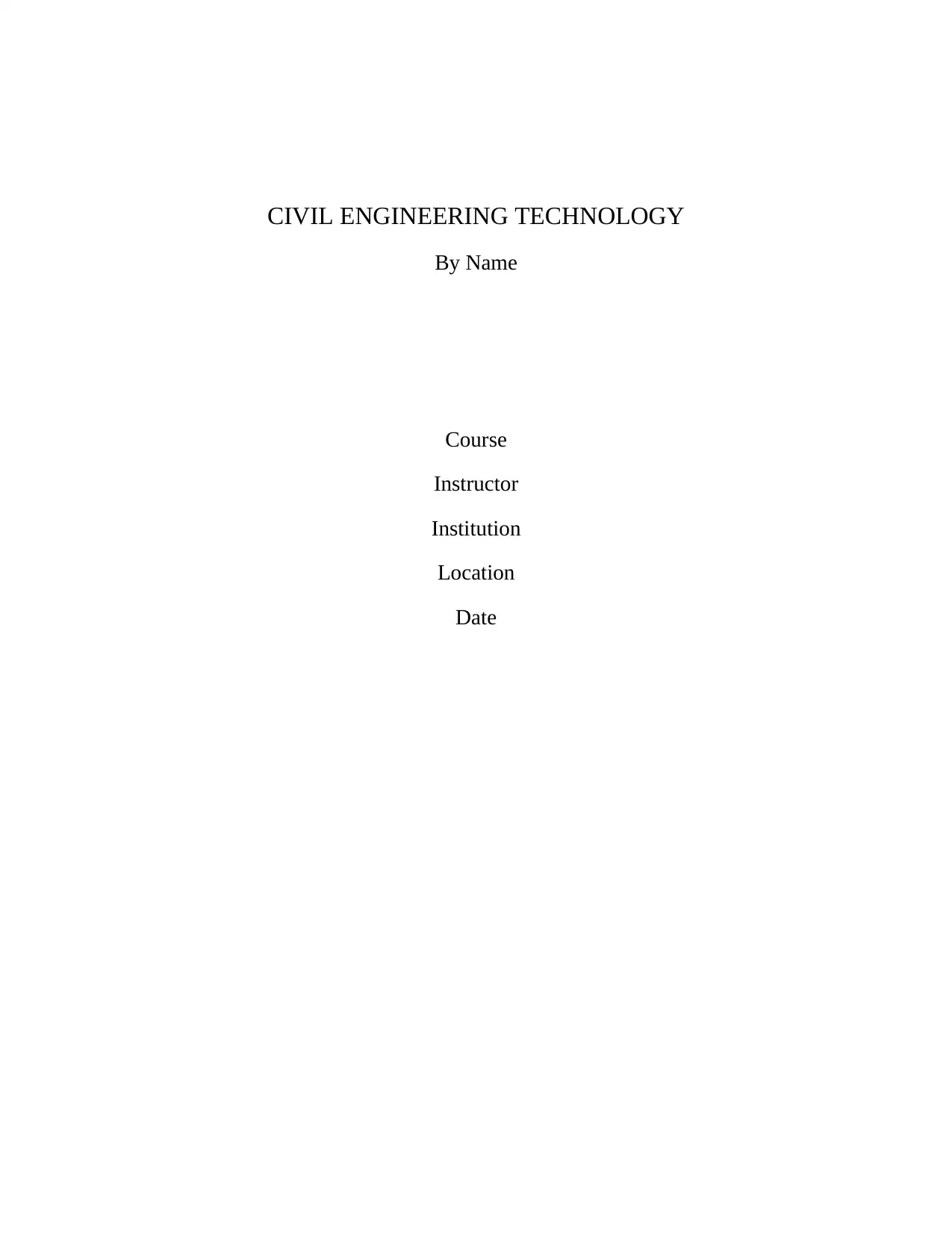
CIVIL ENGINEERING TECHNOLOGY
By Name
Course
Instructor
Institution
Location
Date
By Name
Course
Instructor
Institution
Location
Date
Paraphrase This Document
Need a fresh take? Get an instant paraphrase of this document with our AI Paraphraser

Introduction
Several factors are usually considered during the establishment of any industrial unit. Despite
the fact that engineering feasibility has received very little attention at the expense of the market
availability, it is should be too considered important. Any plant that is properly situated will
basically have the production cost reduced hence the concept of profit margin enhanced. Proper
location of the industrial unit will definitely influence the ease of transport (Bechtel, et al.2017).
According to the provided geographical information of the selected site, several challenges
remain to be addressed technically so as to ease the operation of the industrial unit.
Task 1
Section a: Earthworks
The activities expected in this particular task will include excavating, transporting, placement as
well as screening of cubic metres of materials in thousands. This will basically involve fill
materials to be put to level 1. The strategies of engineering as well as planning will be very
important at this stage so that the project can be completed within the stipulated time.
Degree or scope of work
Transportation after excavation will handle at least 400000 cubic metres of the fill
materials.
Sorting, grading as well as screening of about 11000 cubic meters will then be done
The fill material will then be placed and compacted to at least 1 level (He, Li and Li
2017)
Equipment
Several factors are usually considered during the establishment of any industrial unit. Despite
the fact that engineering feasibility has received very little attention at the expense of the market
availability, it is should be too considered important. Any plant that is properly situated will
basically have the production cost reduced hence the concept of profit margin enhanced. Proper
location of the industrial unit will definitely influence the ease of transport (Bechtel, et al.2017).
According to the provided geographical information of the selected site, several challenges
remain to be addressed technically so as to ease the operation of the industrial unit.
Task 1
Section a: Earthworks
The activities expected in this particular task will include excavating, transporting, placement as
well as screening of cubic metres of materials in thousands. This will basically involve fill
materials to be put to level 1. The strategies of engineering as well as planning will be very
important at this stage so that the project can be completed within the stipulated time.
Degree or scope of work
Transportation after excavation will handle at least 400000 cubic metres of the fill
materials.
Sorting, grading as well as screening of about 11000 cubic meters will then be done
The fill material will then be placed and compacted to at least 1 level (He, Li and Li
2017)
Equipment
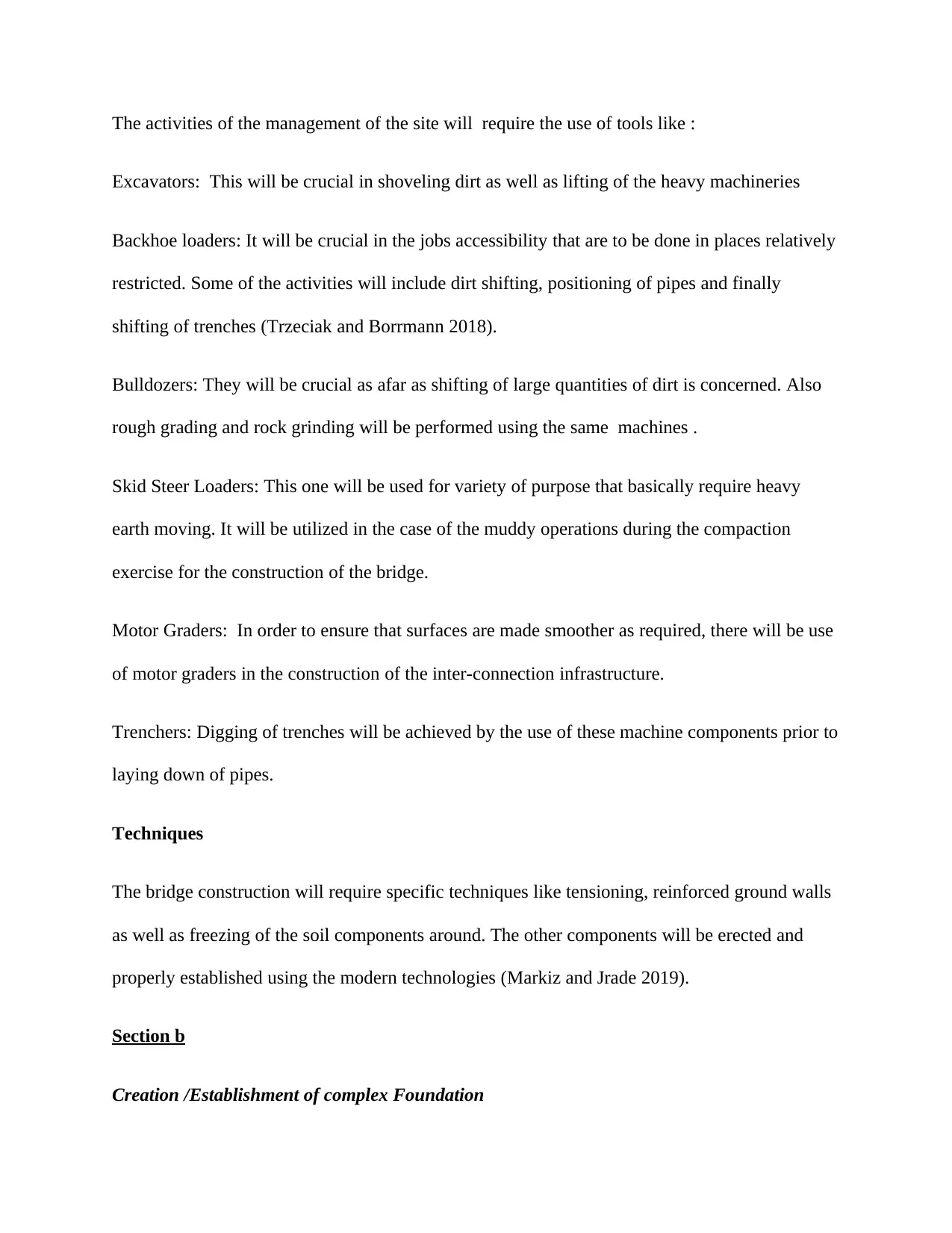
The activities of the management of the site will require the use of tools like :
Excavators: This will be crucial in shoveling dirt as well as lifting of the heavy machineries
Backhoe loaders: It will be crucial in the jobs accessibility that are to be done in places relatively
restricted. Some of the activities will include dirt shifting, positioning of pipes and finally
shifting of trenches (Trzeciak and Borrmann 2018).
Bulldozers: They will be crucial as afar as shifting of large quantities of dirt is concerned. Also
rough grading and rock grinding will be performed using the same machines .
Skid Steer Loaders: This one will be used for variety of purpose that basically require heavy
earth moving. It will be utilized in the case of the muddy operations during the compaction
exercise for the construction of the bridge.
Motor Graders: In order to ensure that surfaces are made smoother as required, there will be use
of motor graders in the construction of the inter-connection infrastructure.
Trenchers: Digging of trenches will be achieved by the use of these machine components prior to
laying down of pipes.
Techniques
The bridge construction will require specific techniques like tensioning, reinforced ground walls
as well as freezing of the soil components around. The other components will be erected and
properly established using the modern technologies (Markiz and Jrade 2019).
Section b
Creation /Establishment of complex Foundation
Excavators: This will be crucial in shoveling dirt as well as lifting of the heavy machineries
Backhoe loaders: It will be crucial in the jobs accessibility that are to be done in places relatively
restricted. Some of the activities will include dirt shifting, positioning of pipes and finally
shifting of trenches (Trzeciak and Borrmann 2018).
Bulldozers: They will be crucial as afar as shifting of large quantities of dirt is concerned. Also
rough grading and rock grinding will be performed using the same machines .
Skid Steer Loaders: This one will be used for variety of purpose that basically require heavy
earth moving. It will be utilized in the case of the muddy operations during the compaction
exercise for the construction of the bridge.
Motor Graders: In order to ensure that surfaces are made smoother as required, there will be use
of motor graders in the construction of the inter-connection infrastructure.
Trenchers: Digging of trenches will be achieved by the use of these machine components prior to
laying down of pipes.
Techniques
The bridge construction will require specific techniques like tensioning, reinforced ground walls
as well as freezing of the soil components around. The other components will be erected and
properly established using the modern technologies (Markiz and Jrade 2019).
Section b
Creation /Establishment of complex Foundation
⊘ This is a preview!⊘
Do you want full access?
Subscribe today to unlock all pages.

Trusted by 1+ million students worldwide
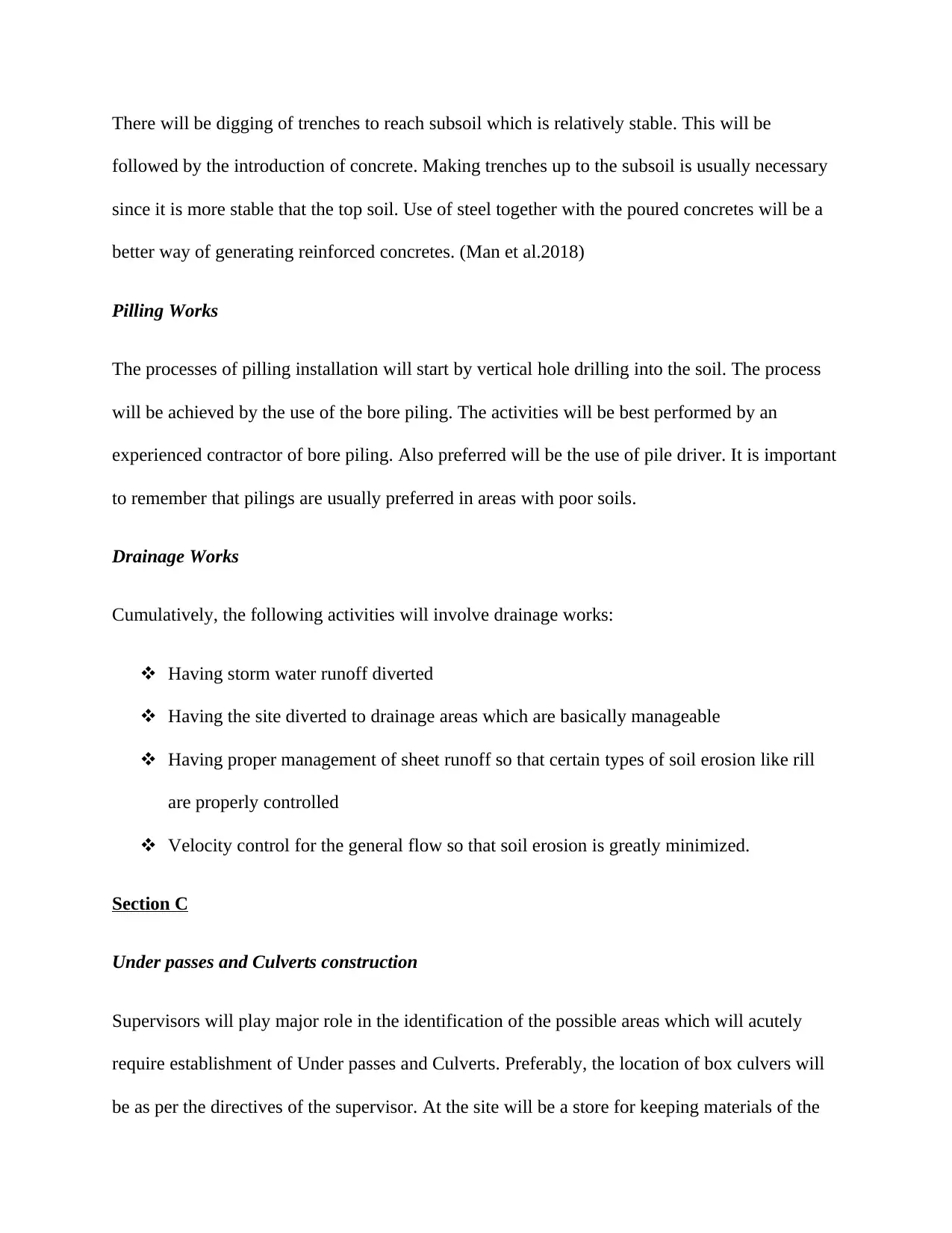
There will be digging of trenches to reach subsoil which is relatively stable. This will be
followed by the introduction of concrete. Making trenches up to the subsoil is usually necessary
since it is more stable that the top soil. Use of steel together with the poured concretes will be a
better way of generating reinforced concretes. (Man et al.2018)
Pilling Works
The processes of pilling installation will start by vertical hole drilling into the soil. The process
will be achieved by the use of the bore piling. The activities will be best performed by an
experienced contractor of bore piling. Also preferred will be the use of pile driver. It is important
to remember that pilings are usually preferred in areas with poor soils.
Drainage Works
Cumulatively, the following activities will involve drainage works:
Having storm water runoff diverted
Having the site diverted to drainage areas which are basically manageable
Having proper management of sheet runoff so that certain types of soil erosion like rill
are properly controlled
Velocity control for the general flow so that soil erosion is greatly minimized.
Section C
Under passes and Culverts construction
Supervisors will play major role in the identification of the possible areas which will acutely
require establishment of Under passes and Culverts. Preferably, the location of box culvers will
be as per the directives of the supervisor. At the site will be a store for keeping materials of the
followed by the introduction of concrete. Making trenches up to the subsoil is usually necessary
since it is more stable that the top soil. Use of steel together with the poured concretes will be a
better way of generating reinforced concretes. (Man et al.2018)
Pilling Works
The processes of pilling installation will start by vertical hole drilling into the soil. The process
will be achieved by the use of the bore piling. The activities will be best performed by an
experienced contractor of bore piling. Also preferred will be the use of pile driver. It is important
to remember that pilings are usually preferred in areas with poor soils.
Drainage Works
Cumulatively, the following activities will involve drainage works:
Having storm water runoff diverted
Having the site diverted to drainage areas which are basically manageable
Having proper management of sheet runoff so that certain types of soil erosion like rill
are properly controlled
Velocity control for the general flow so that soil erosion is greatly minimized.
Section C
Under passes and Culverts construction
Supervisors will play major role in the identification of the possible areas which will acutely
require establishment of Under passes and Culverts. Preferably, the location of box culvers will
be as per the directives of the supervisor. At the site will be a store for keeping materials of the
Paraphrase This Document
Need a fresh take? Get an instant paraphrase of this document with our AI Paraphraser
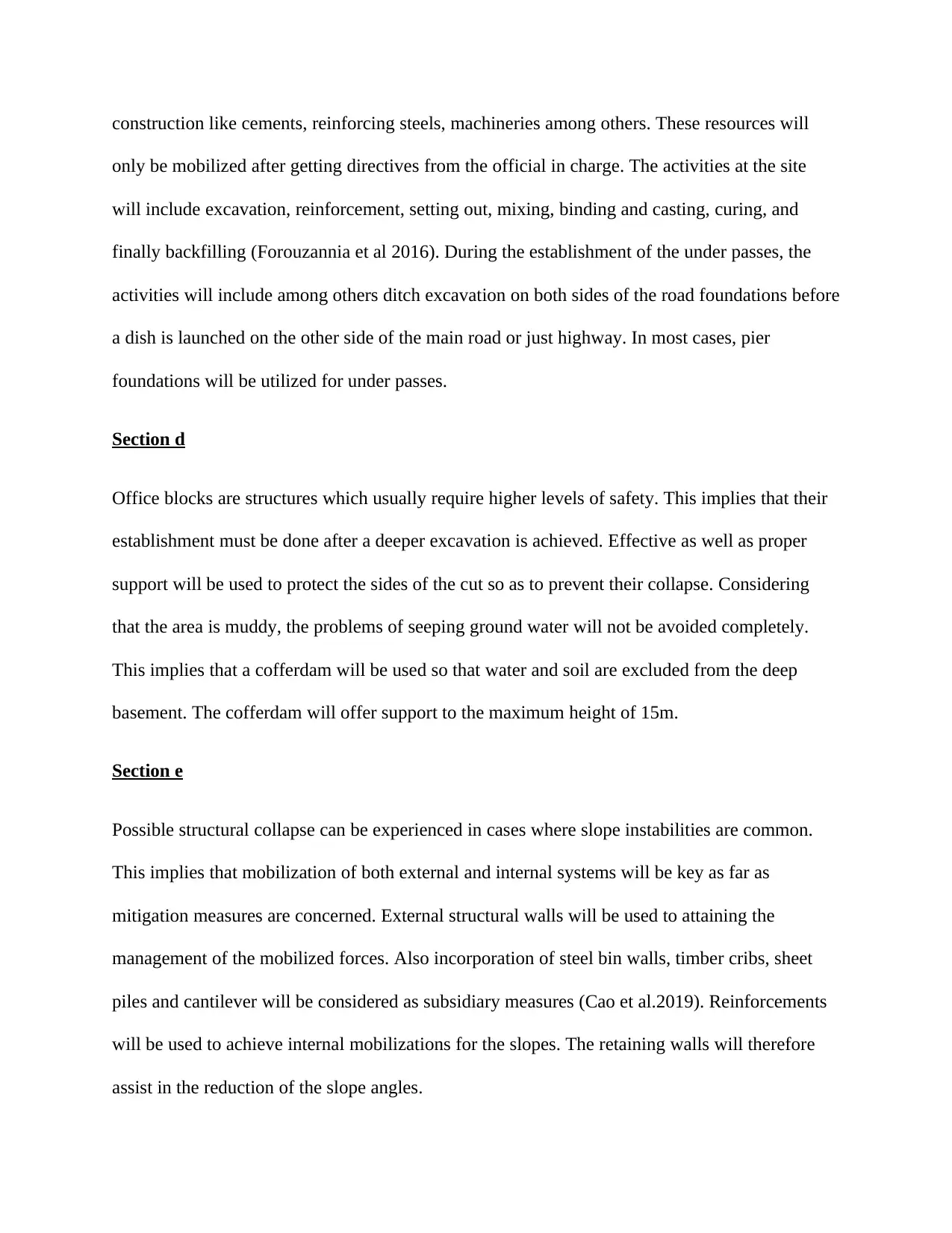
construction like cements, reinforcing steels, machineries among others. These resources will
only be mobilized after getting directives from the official in charge. The activities at the site
will include excavation, reinforcement, setting out, mixing, binding and casting, curing, and
finally backfilling (Forouzannia et al 2016). During the establishment of the under passes, the
activities will include among others ditch excavation on both sides of the road foundations before
a dish is launched on the other side of the main road or just highway. In most cases, pier
foundations will be utilized for under passes.
Section d
Office blocks are structures which usually require higher levels of safety. This implies that their
establishment must be done after a deeper excavation is achieved. Effective as well as proper
support will be used to protect the sides of the cut so as to prevent their collapse. Considering
that the area is muddy, the problems of seeping ground water will not be avoided completely.
This implies that a cofferdam will be used so that water and soil are excluded from the deep
basement. The cofferdam will offer support to the maximum height of 15m.
Section e
Possible structural collapse can be experienced in cases where slope instabilities are common.
This implies that mobilization of both external and internal systems will be key as far as
mitigation measures are concerned. External structural walls will be used to attaining the
management of the mobilized forces. Also incorporation of steel bin walls, timber cribs, sheet
piles and cantilever will be considered as subsidiary measures (Cao et al.2019). Reinforcements
will be used to achieve internal mobilizations for the slopes. The retaining walls will therefore
assist in the reduction of the slope angles.
only be mobilized after getting directives from the official in charge. The activities at the site
will include excavation, reinforcement, setting out, mixing, binding and casting, curing, and
finally backfilling (Forouzannia et al 2016). During the establishment of the under passes, the
activities will include among others ditch excavation on both sides of the road foundations before
a dish is launched on the other side of the main road or just highway. In most cases, pier
foundations will be utilized for under passes.
Section d
Office blocks are structures which usually require higher levels of safety. This implies that their
establishment must be done after a deeper excavation is achieved. Effective as well as proper
support will be used to protect the sides of the cut so as to prevent their collapse. Considering
that the area is muddy, the problems of seeping ground water will not be avoided completely.
This implies that a cofferdam will be used so that water and soil are excluded from the deep
basement. The cofferdam will offer support to the maximum height of 15m.
Section e
Possible structural collapse can be experienced in cases where slope instabilities are common.
This implies that mobilization of both external and internal systems will be key as far as
mitigation measures are concerned. External structural walls will be used to attaining the
management of the mobilized forces. Also incorporation of steel bin walls, timber cribs, sheet
piles and cantilever will be considered as subsidiary measures (Cao et al.2019). Reinforcements
will be used to achieve internal mobilizations for the slopes. The retaining walls will therefore
assist in the reduction of the slope angles.
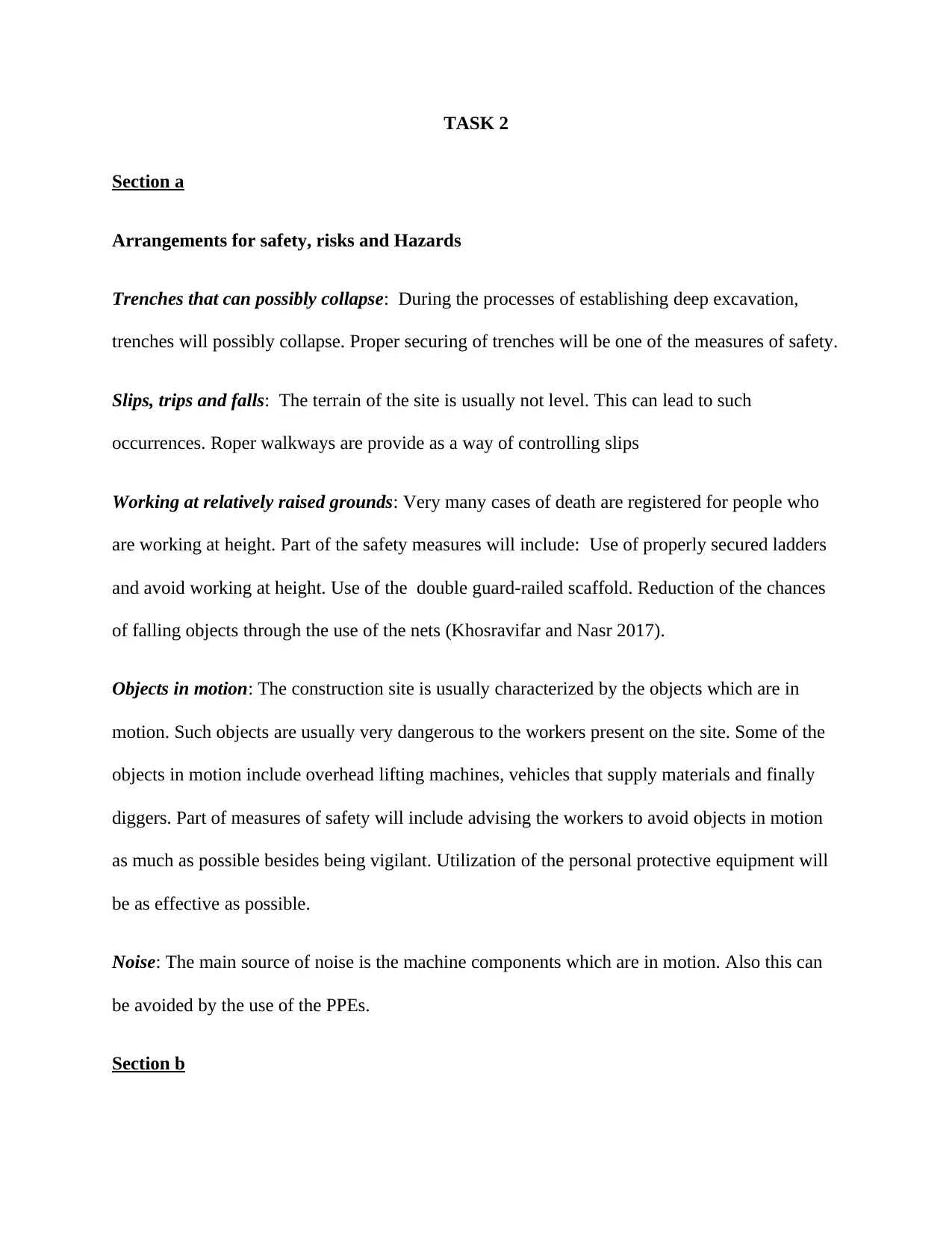
TASK 2
Section a
Arrangements for safety, risks and Hazards
Trenches that can possibly collapse: During the processes of establishing deep excavation,
trenches will possibly collapse. Proper securing of trenches will be one of the measures of safety.
Slips, trips and falls: The terrain of the site is usually not level. This can lead to such
occurrences. Roper walkways are provide as a way of controlling slips
Working at relatively raised grounds: Very many cases of death are registered for people who
are working at height. Part of the safety measures will include: Use of properly secured ladders
and avoid working at height. Use of the double guard-railed scaffold. Reduction of the chances
of falling objects through the use of the nets (Khosravifar and Nasr 2017).
Objects in motion: The construction site is usually characterized by the objects which are in
motion. Such objects are usually very dangerous to the workers present on the site. Some of the
objects in motion include overhead lifting machines, vehicles that supply materials and finally
diggers. Part of measures of safety will include advising the workers to avoid objects in motion
as much as possible besides being vigilant. Utilization of the personal protective equipment will
be as effective as possible.
Noise: The main source of noise is the machine components which are in motion. Also this can
be avoided by the use of the PPEs.
Section b
Section a
Arrangements for safety, risks and Hazards
Trenches that can possibly collapse: During the processes of establishing deep excavation,
trenches will possibly collapse. Proper securing of trenches will be one of the measures of safety.
Slips, trips and falls: The terrain of the site is usually not level. This can lead to such
occurrences. Roper walkways are provide as a way of controlling slips
Working at relatively raised grounds: Very many cases of death are registered for people who
are working at height. Part of the safety measures will include: Use of properly secured ladders
and avoid working at height. Use of the double guard-railed scaffold. Reduction of the chances
of falling objects through the use of the nets (Khosravifar and Nasr 2017).
Objects in motion: The construction site is usually characterized by the objects which are in
motion. Such objects are usually very dangerous to the workers present on the site. Some of the
objects in motion include overhead lifting machines, vehicles that supply materials and finally
diggers. Part of measures of safety will include advising the workers to avoid objects in motion
as much as possible besides being vigilant. Utilization of the personal protective equipment will
be as effective as possible.
Noise: The main source of noise is the machine components which are in motion. Also this can
be avoided by the use of the PPEs.
Section b
⊘ This is a preview!⊘
Do you want full access?
Subscribe today to unlock all pages.

Trusted by 1+ million students worldwide
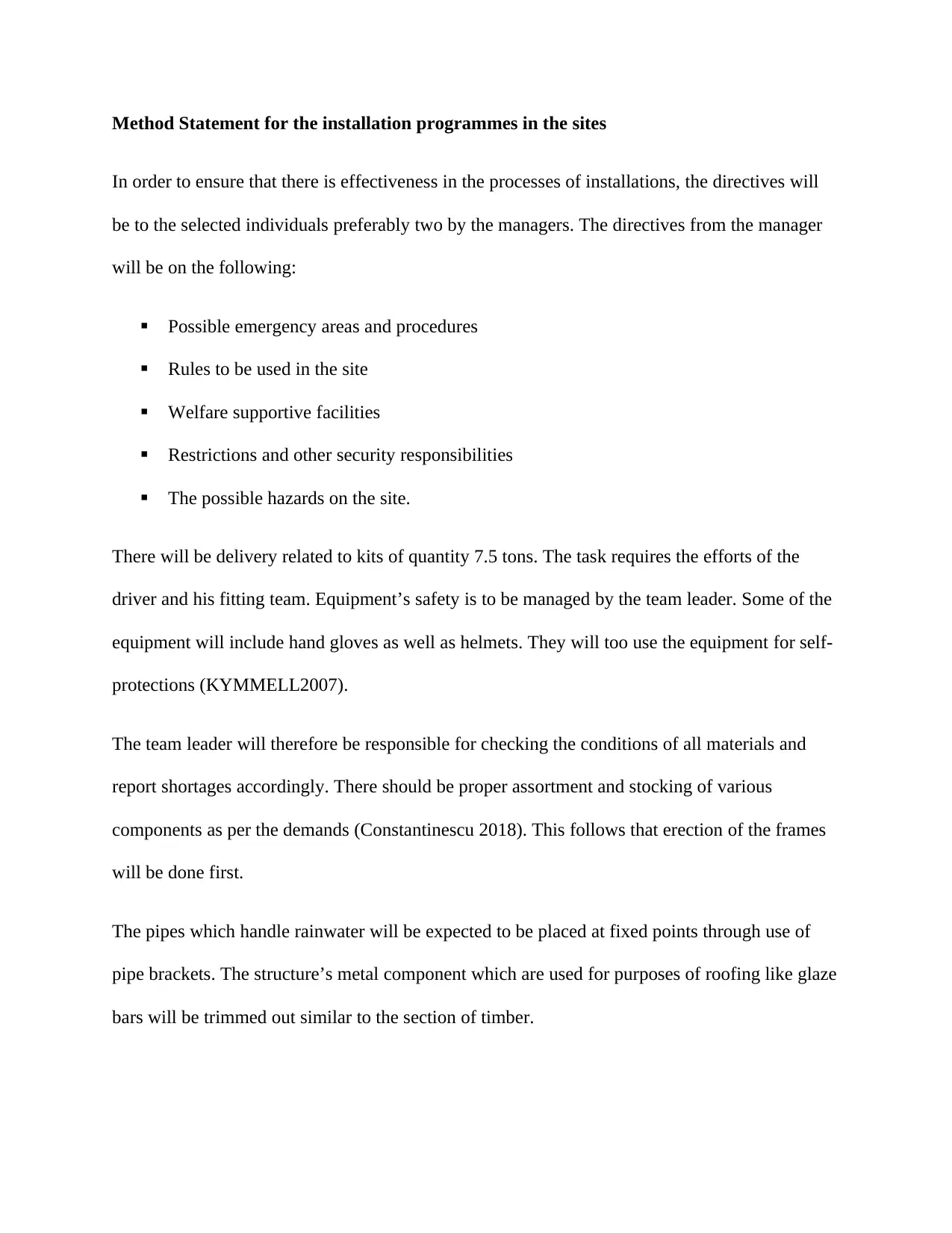
Method Statement for the installation programmes in the sites
In order to ensure that there is effectiveness in the processes of installations, the directives will
be to the selected individuals preferably two by the managers. The directives from the manager
will be on the following:
Possible emergency areas and procedures
Rules to be used in the site
Welfare supportive facilities
Restrictions and other security responsibilities
The possible hazards on the site.
There will be delivery related to kits of quantity 7.5 tons. The task requires the efforts of the
driver and his fitting team. Equipment’s safety is to be managed by the team leader. Some of the
equipment will include hand gloves as well as helmets. They will too use the equipment for self-
protections (KYMMELL2007).
The team leader will therefore be responsible for checking the conditions of all materials and
report shortages accordingly. There should be proper assortment and stocking of various
components as per the demands (Constantinescu 2018). This follows that erection of the frames
will be done first.
The pipes which handle rainwater will be expected to be placed at fixed points through use of
pipe brackets. The structure’s metal component which are used for purposes of roofing like glaze
bars will be trimmed out similar to the section of timber.
In order to ensure that there is effectiveness in the processes of installations, the directives will
be to the selected individuals preferably two by the managers. The directives from the manager
will be on the following:
Possible emergency areas and procedures
Rules to be used in the site
Welfare supportive facilities
Restrictions and other security responsibilities
The possible hazards on the site.
There will be delivery related to kits of quantity 7.5 tons. The task requires the efforts of the
driver and his fitting team. Equipment’s safety is to be managed by the team leader. Some of the
equipment will include hand gloves as well as helmets. They will too use the equipment for self-
protections (KYMMELL2007).
The team leader will therefore be responsible for checking the conditions of all materials and
report shortages accordingly. There should be proper assortment and stocking of various
components as per the demands (Constantinescu 2018). This follows that erection of the frames
will be done first.
The pipes which handle rainwater will be expected to be placed at fixed points through use of
pipe brackets. The structure’s metal component which are used for purposes of roofing like glaze
bars will be trimmed out similar to the section of timber.
Paraphrase This Document
Need a fresh take? Get an instant paraphrase of this document with our AI Paraphraser
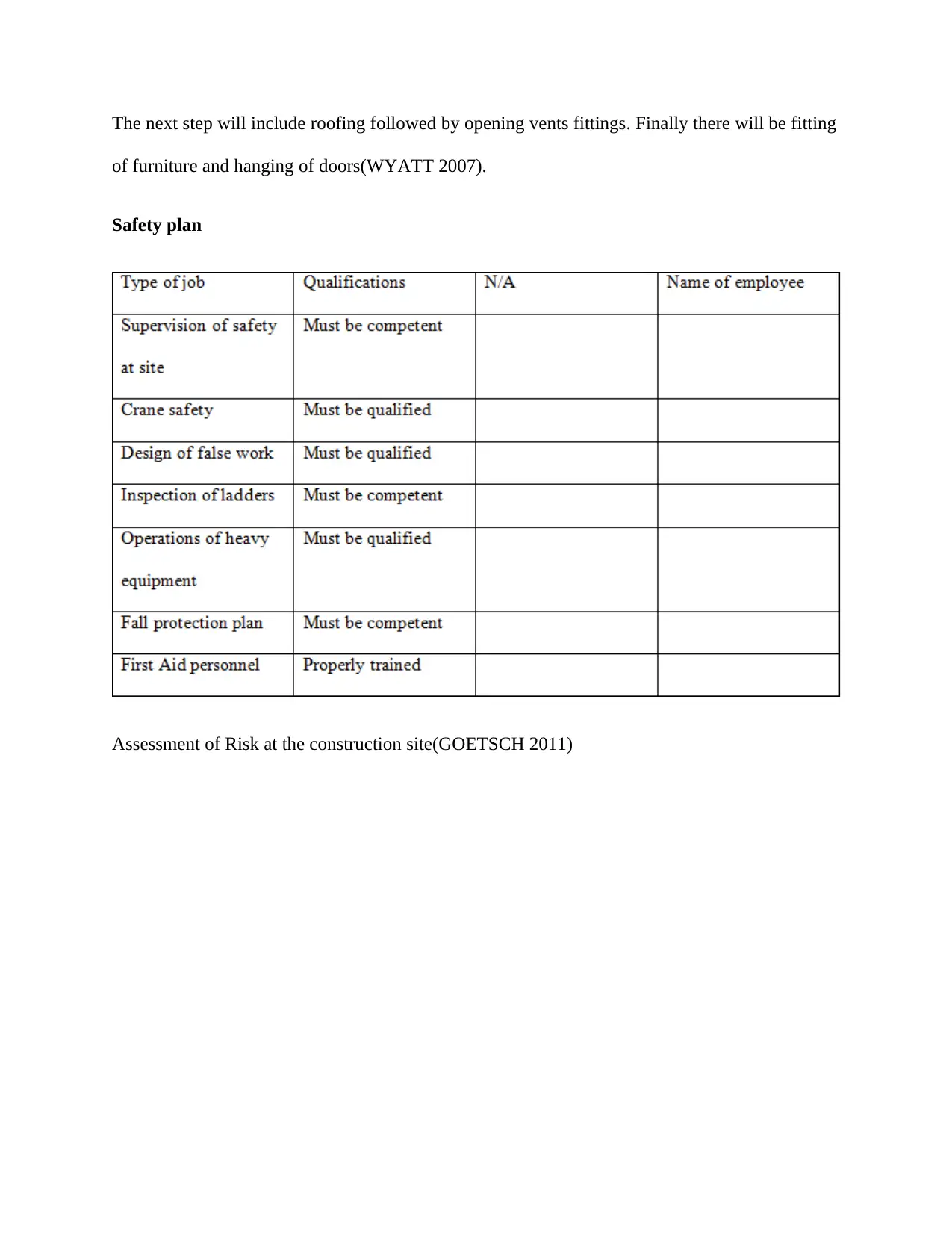
The next step will include roofing followed by opening vents fittings. Finally there will be fitting
of furniture and hanging of doors(WYATT 2007).
Safety plan
Assessment of Risk at the construction site(GOETSCH 2011)
of furniture and hanging of doors(WYATT 2007).
Safety plan
Assessment of Risk at the construction site(GOETSCH 2011)
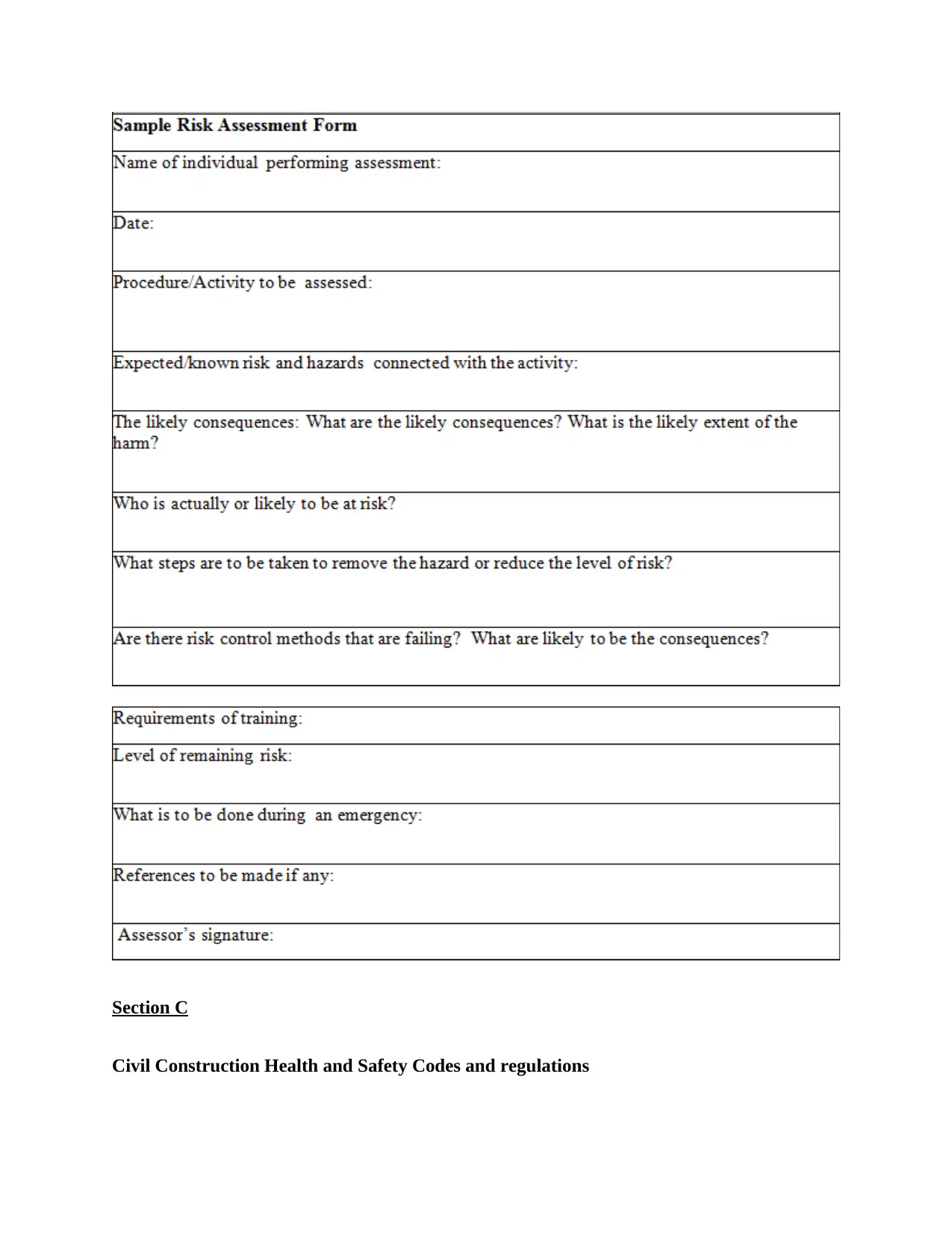
Section C
Civil Construction Health and Safety Codes and regulations
Civil Construction Health and Safety Codes and regulations
⊘ This is a preview!⊘
Do you want full access?
Subscribe today to unlock all pages.

Trusted by 1+ million students worldwide
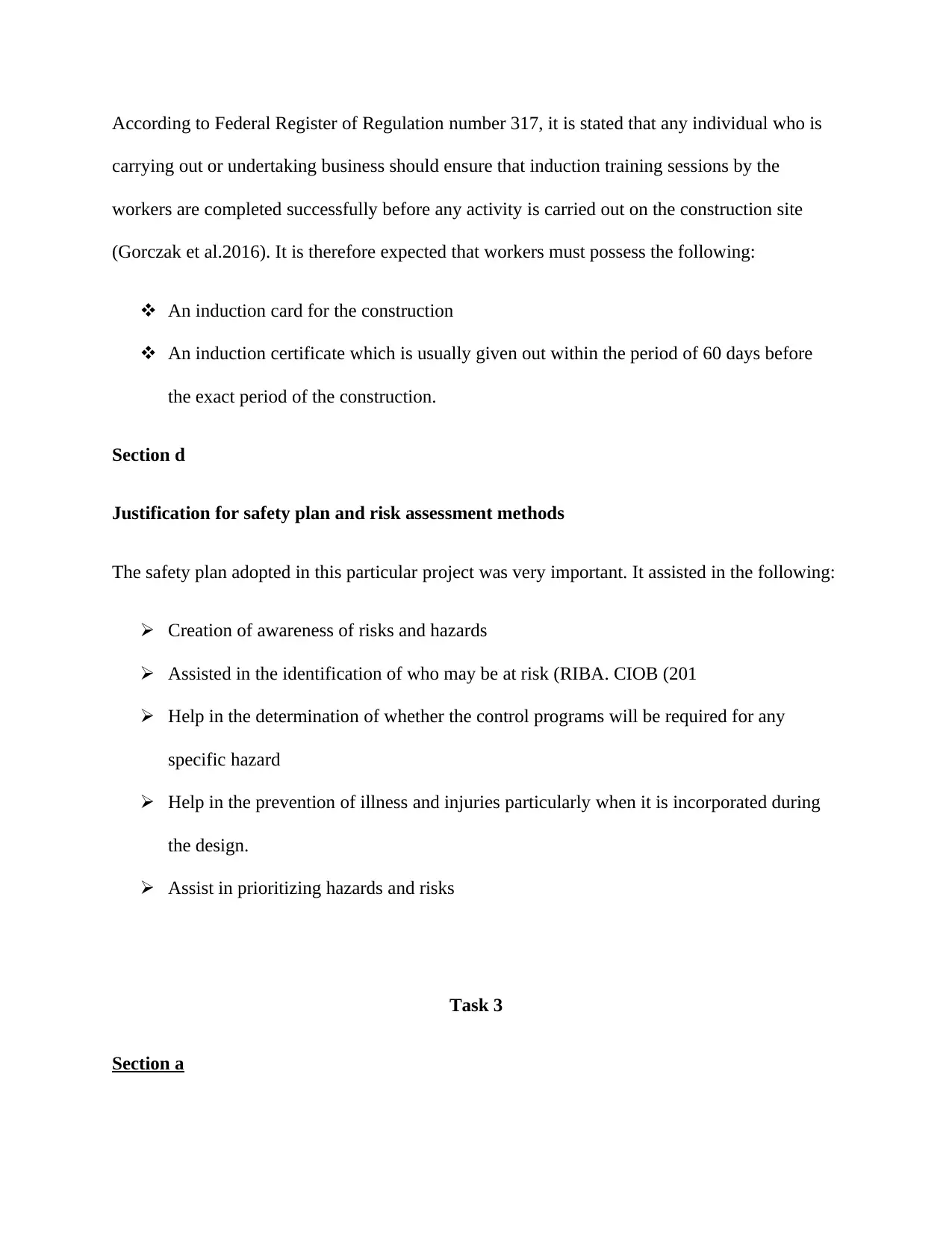
According to Federal Register of Regulation number 317, it is stated that any individual who is
carrying out or undertaking business should ensure that induction training sessions by the
workers are completed successfully before any activity is carried out on the construction site
(Gorczak et al.2016). It is therefore expected that workers must possess the following:
An induction card for the construction
An induction certificate which is usually given out within the period of 60 days before
the exact period of the construction.
Section d
Justification for safety plan and risk assessment methods
The safety plan adopted in this particular project was very important. It assisted in the following:
Creation of awareness of risks and hazards
Assisted in the identification of who may be at risk (RIBA. CIOB (201
Help in the determination of whether the control programs will be required for any
specific hazard
Help in the prevention of illness and injuries particularly when it is incorporated during
the design.
Assist in prioritizing hazards and risks
Task 3
Section a
carrying out or undertaking business should ensure that induction training sessions by the
workers are completed successfully before any activity is carried out on the construction site
(Gorczak et al.2016). It is therefore expected that workers must possess the following:
An induction card for the construction
An induction certificate which is usually given out within the period of 60 days before
the exact period of the construction.
Section d
Justification for safety plan and risk assessment methods
The safety plan adopted in this particular project was very important. It assisted in the following:
Creation of awareness of risks and hazards
Assisted in the identification of who may be at risk (RIBA. CIOB (201
Help in the determination of whether the control programs will be required for any
specific hazard
Help in the prevention of illness and injuries particularly when it is incorporated during
the design.
Assist in prioritizing hazards and risks
Task 3
Section a
Paraphrase This Document
Need a fresh take? Get an instant paraphrase of this document with our AI Paraphraser
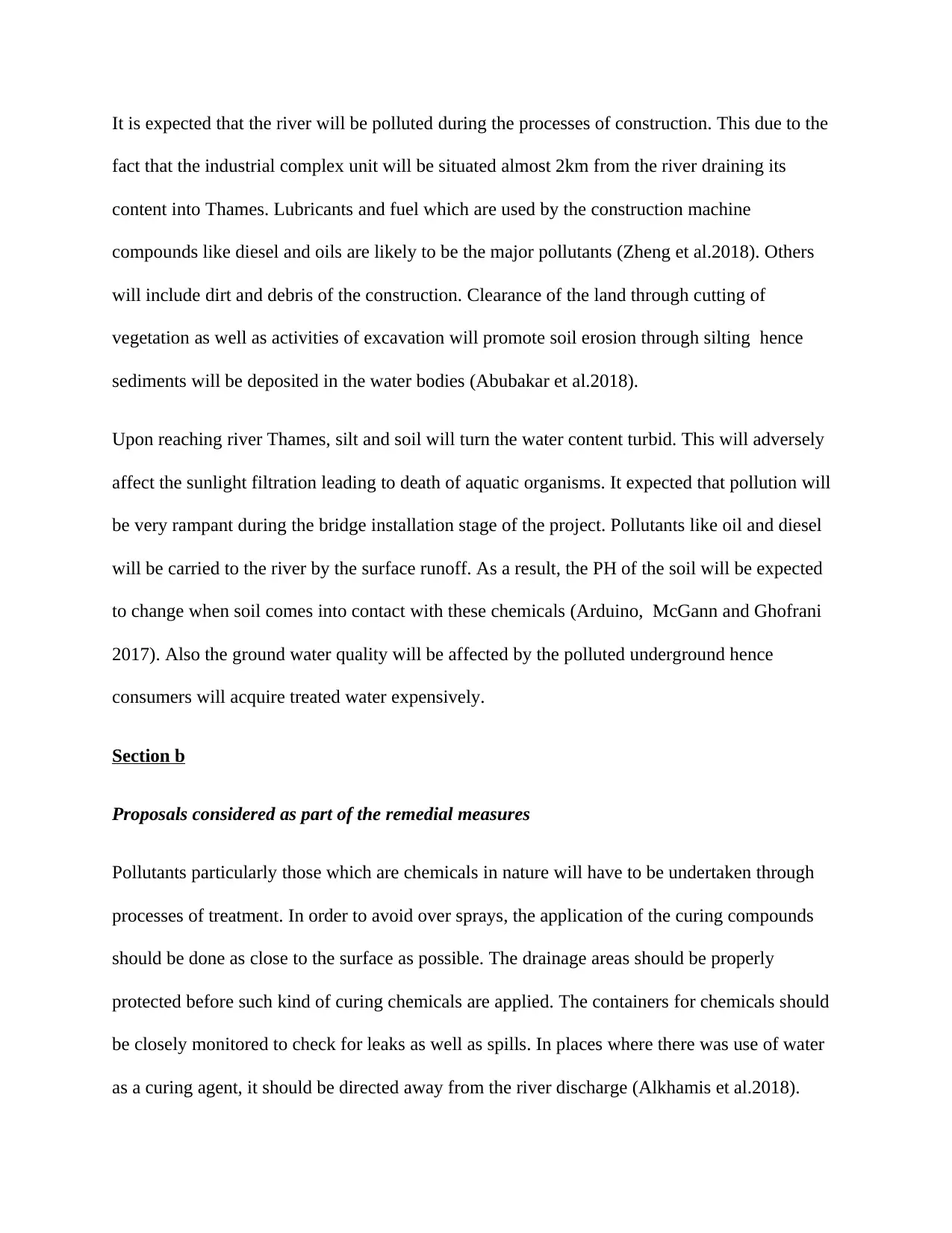
It is expected that the river will be polluted during the processes of construction. This due to the
fact that the industrial complex unit will be situated almost 2km from the river draining its
content into Thames. Lubricants and fuel which are used by the construction machine
compounds like diesel and oils are likely to be the major pollutants (Zheng et al.2018). Others
will include dirt and debris of the construction. Clearance of the land through cutting of
vegetation as well as activities of excavation will promote soil erosion through silting hence
sediments will be deposited in the water bodies (Abubakar et al.2018).
Upon reaching river Thames, silt and soil will turn the water content turbid. This will adversely
affect the sunlight filtration leading to death of aquatic organisms. It expected that pollution will
be very rampant during the bridge installation stage of the project. Pollutants like oil and diesel
will be carried to the river by the surface runoff. As a result, the PH of the soil will be expected
to change when soil comes into contact with these chemicals (Arduino, McGann and Ghofrani
2017). Also the ground water quality will be affected by the polluted underground hence
consumers will acquire treated water expensively.
Section b
Proposals considered as part of the remedial measures
Pollutants particularly those which are chemicals in nature will have to be undertaken through
processes of treatment. In order to avoid over sprays, the application of the curing compounds
should be done as close to the surface as possible. The drainage areas should be properly
protected before such kind of curing chemicals are applied. The containers for chemicals should
be closely monitored to check for leaks as well as spills. In places where there was use of water
as a curing agent, it should be directed away from the river discharge (Alkhamis et al.2018).
fact that the industrial complex unit will be situated almost 2km from the river draining its
content into Thames. Lubricants and fuel which are used by the construction machine
compounds like diesel and oils are likely to be the major pollutants (Zheng et al.2018). Others
will include dirt and debris of the construction. Clearance of the land through cutting of
vegetation as well as activities of excavation will promote soil erosion through silting hence
sediments will be deposited in the water bodies (Abubakar et al.2018).
Upon reaching river Thames, silt and soil will turn the water content turbid. This will adversely
affect the sunlight filtration leading to death of aquatic organisms. It expected that pollution will
be very rampant during the bridge installation stage of the project. Pollutants like oil and diesel
will be carried to the river by the surface runoff. As a result, the PH of the soil will be expected
to change when soil comes into contact with these chemicals (Arduino, McGann and Ghofrani
2017). Also the ground water quality will be affected by the polluted underground hence
consumers will acquire treated water expensively.
Section b
Proposals considered as part of the remedial measures
Pollutants particularly those which are chemicals in nature will have to be undertaken through
processes of treatment. In order to avoid over sprays, the application of the curing compounds
should be done as close to the surface as possible. The drainage areas should be properly
protected before such kind of curing chemicals are applied. The containers for chemicals should
be closely monitored to check for leaks as well as spills. In places where there was use of water
as a curing agent, it should be directed away from the river discharge (Alkhamis et al.2018).
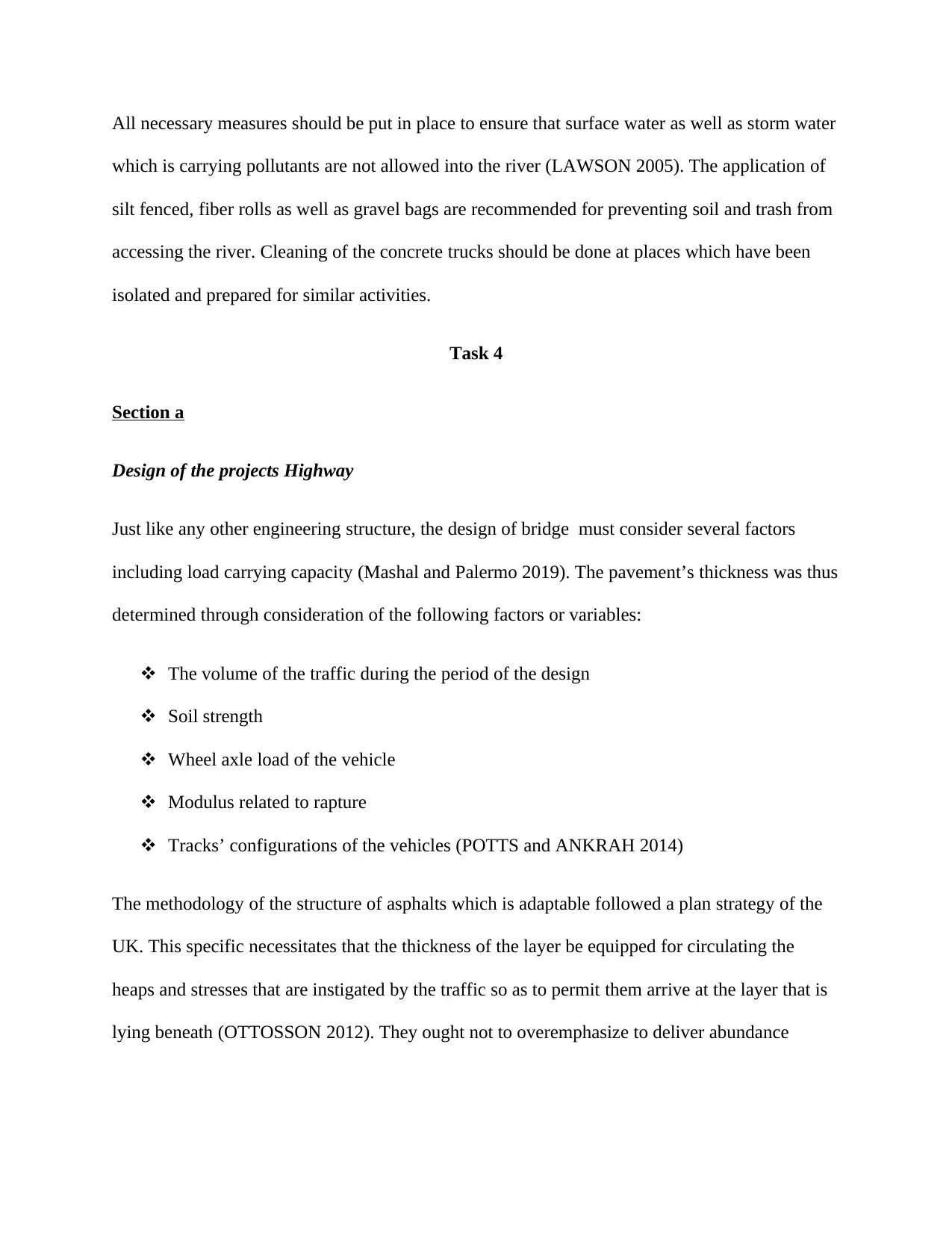
All necessary measures should be put in place to ensure that surface water as well as storm water
which is carrying pollutants are not allowed into the river (LAWSON 2005). The application of
silt fenced, fiber rolls as well as gravel bags are recommended for preventing soil and trash from
accessing the river. Cleaning of the concrete trucks should be done at places which have been
isolated and prepared for similar activities.
Task 4
Section a
Design of the projects Highway
Just like any other engineering structure, the design of bridge must consider several factors
including load carrying capacity (Mashal and Palermo 2019). The pavement’s thickness was thus
determined through consideration of the following factors or variables:
The volume of the traffic during the period of the design
Soil strength
Wheel axle load of the vehicle
Modulus related to rapture
Tracks’ configurations of the vehicles (POTTS and ANKRAH 2014)
The methodology of the structure of asphalts which is adaptable followed a plan strategy of the
UK. This specific necessitates that the thickness of the layer be equipped for circulating the
heaps and stresses that are instigated by the traffic so as to permit them arrive at the layer that is
lying beneath (OTTOSSON 2012). They ought not to overemphasize to deliver abundance
which is carrying pollutants are not allowed into the river (LAWSON 2005). The application of
silt fenced, fiber rolls as well as gravel bags are recommended for preventing soil and trash from
accessing the river. Cleaning of the concrete trucks should be done at places which have been
isolated and prepared for similar activities.
Task 4
Section a
Design of the projects Highway
Just like any other engineering structure, the design of bridge must consider several factors
including load carrying capacity (Mashal and Palermo 2019). The pavement’s thickness was thus
determined through consideration of the following factors or variables:
The volume of the traffic during the period of the design
Soil strength
Wheel axle load of the vehicle
Modulus related to rapture
Tracks’ configurations of the vehicles (POTTS and ANKRAH 2014)
The methodology of the structure of asphalts which is adaptable followed a plan strategy of the
UK. This specific necessitates that the thickness of the layer be equipped for circulating the
heaps and stresses that are instigated by the traffic so as to permit them arrive at the layer that is
lying beneath (OTTOSSON 2012). They ought not to overemphasize to deliver abundance
⊘ This is a preview!⊘
Do you want full access?
Subscribe today to unlock all pages.

Trusted by 1+ million students worldwide
1 out of 19
Related Documents
Your All-in-One AI-Powered Toolkit for Academic Success.
+13062052269
info@desklib.com
Available 24*7 on WhatsApp / Email
![[object Object]](/_next/static/media/star-bottom.7253800d.svg)
Unlock your academic potential
Copyright © 2020–2025 A2Z Services. All Rights Reserved. Developed and managed by ZUCOL.



